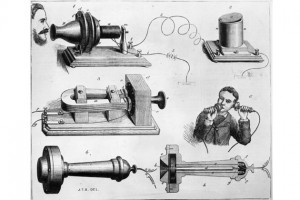Case Studies in Technological Change
 To paraphrase Robert Allen and Douglas Gomery in Film History: Theory and Practice, media depends on machines. Technology contextualizes industrial and stylistic change, reveals and obscures sites of cultural negotiation and meaning, and enables new modes of media production, circulation, and reception. The significance of technology to media studies has only become more acute with the proliferation of digital technologies, which have changed the methods and tools of our scholarship—to say nothing of the object of that study.
To paraphrase Robert Allen and Douglas Gomery in Film History: Theory and Practice, media depends on machines. Technology contextualizes industrial and stylistic change, reveals and obscures sites of cultural negotiation and meaning, and enables new modes of media production, circulation, and reception. The significance of technology to media studies has only become more acute with the proliferation of digital technologies, which have changed the methods and tools of our scholarship—to say nothing of the object of that study.
Too often, however, scholarship relegates technology to the background, rendering it less an object of study in and of itself than a cause of, or context for, broader situations. While useful and often necessary, this tendency can have unintended consequences. It risks the assumption that technological changes automatically engender concomitant changes in our “real” object of study, when representations and practices that endure despite technological change offer equally important insight. Similarly, focusing on broader trends may steer us away from failed efforts at technological change, where entrenched structures of cultural or industrial design are exposed and tested, while treating technology as the agent of change can ignore the roles of cultural and industrial demands in technological advancement or stasis.
 These are the issues the editors of The Velvet Light Trap hope to explore in its upcoming issue. Seeking case studies of historical and contemporary technological change that privilege technology itself as the object of study, they hope to focus the issue’s attention on specific technological changes in context rather than theories that explore how technology in broad terms is changing media and culture. VLT welcomes submissions that reexamine accepted histories of technological change, reveal little-known changes worthy of attention, or show important continuities despite technological change. For those interested, please send anonymous electronic submissions between 8,000 and 10,000 words in Chicago style along with a one-page abstract by August 1, 2014. To submit a paper or to learn more, send an email to thevelvetlighttrap@gmail.com.
These are the issues the editors of The Velvet Light Trap hope to explore in its upcoming issue. Seeking case studies of historical and contemporary technological change that privilege technology itself as the object of study, they hope to focus the issue’s attention on specific technological changes in context rather than theories that explore how technology in broad terms is changing media and culture. VLT welcomes submissions that reexamine accepted histories of technological change, reveal little-known changes worthy of attention, or show important continuities despite technological change. For those interested, please send anonymous electronic submissions between 8,000 and 10,000 words in Chicago style along with a one-page abstract by August 1, 2014. To submit a paper or to learn more, send an email to thevelvetlighttrap@gmail.com.



Great idea VLT. I suspect in the past we’ve been so cautious about technological determinism that it’s hampered serious considerations of technological affordances, change and failures. I’m happy to see technology is trending in media studies!